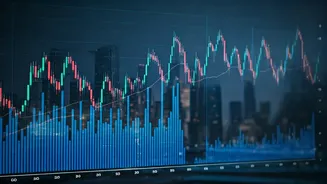Nifty's Recent Summit
Nifty, having attained a significant peak, has entered a phase of consolidation. The index, after a sustained period of growth, began to exhibit sideways
movement. This pause at the summit reflects a period of reflection where investors and market participants reassess valuations and future prospects. This pause can be interpreted in several ways, including profit-taking by investors, a re-evaluation of current market conditions, or an anticipation of upcoming economic data releases and corporate earnings. This period is a natural part of the market cycle, as upward trends cannot continue indefinitely without periods of adjustment. This consolidation can provide a foundation for the next stage of market activity.
Factors Driving Pause
Several factors contribute to Nifty's current consolidation. Firstly, a general atmosphere of caution often prevails after significant market rallies. Investors may choose to secure profits, leading to selling pressure that can curb further immediate growth. Secondly, economic indicators and upcoming policy announcements can cause uncertainty. For example, changes in interest rates, inflation figures, and government initiatives play a significant role. Thirdly, global market trends are influential. Developments in international markets, such as fluctuations in major indices, can trigger cautious behavior among domestic investors. Geopolitical events also can create volatility. Finally, earnings reports from major companies can also trigger the market to pause. The performance of these companies will ultimately affect the Nifty index.
Analyzing Market Dynamics
Understanding market dynamics is vital to interpreting Nifty's current behavior. Supply and demand forces are fundamentally at play. During periods of consolidation, the supply of stocks offered for sale can equal the demand from investors, thus preventing significant movements in either direction. Investor sentiment also influences market behavior. If the overall outlook becomes more optimistic, the market can resume its upward trajectory. Technical analysis provides insights. Analysts often watch for key support and resistance levels, which can predict potential future movement. Support levels indicate where the index is likely to find buyers, and resistance indicates where sellers may enter the market, thereby limiting the index’s growth. These dynamic elements work in concert to shape the market's direction.
Future Outlook and Prospects
Looking ahead, the direction of Nifty hinges on several factors. Economic data releases will be crucial in shaping investor expectations. Positive economic indicators, such as strong GDP growth, low inflation, and robust corporate earnings, could boost investor confidence and encourage buying. Conversely, negative data could trigger a sell-off. Policy decisions by the Reserve Bank of India (RBI) and the government will also be vital. Announcements related to interest rates, tax policies, and infrastructure spending can significantly impact market sentiment. Global economic trends and international events will influence domestic markets. The state of major economies and any geopolitical developments will be watched closely. Finally, corporate earnings will be a key determinant. If major companies report better-than-expected earnings, it will support the index's growth. Conversely, weak earnings could lead to market correction.
Impact of External Factors
External factors play a crucial role in influencing Nifty's performance. The global economic environment is a primary driver. Changes in the economies of the U.S., Europe, and China often affect the Indian market, given their interconnectedness through trade and investment. Geopolitical events, such as trade disputes, political instability, and military conflicts, can lead to market volatility. Currency fluctuations, including the value of the Indian rupee against the U.S. dollar, also play a significant role. A weaker rupee can boost exports but can also increase the cost of imports, creating mixed effects on the market. Investor confidence is also affected by factors such as the stability of global markets, the outlook for specific sectors, and the overall macroeconomic environment.











